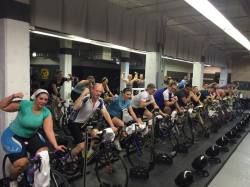There is an adage in the training world that the optimum training load will be the least amount of work that produces the desired results. Many athletes though are of the “more is better--and more than that is best” philosophy. In many cases, the reality is that more training is not a valid solution to the problem of improving as an endurance athlete. Shifting the mindset from one that focuses on completing a certain amount of training volume to one that evaluates the merits of the program based on the achieved results may help to better integrate performance expectations with the very real constraints that athletes face.
A useful starting point in making this shift is examining your relationship with exercise. Do you know why you feel compelled to train, whether or not you actually get the training in? Do you look forward to training? Are other areas of your life put on hold or is training at the bottom of a long list of things to be done each day? A clear understanding of the answers to these questions is essential to finding the life balance we have discussed many times in the past.
Your life can be looked at as a pie. For most people, that pie has four key slices: work, family, training and sleep. Exactly how these slices are apportioned will be different for each athlete and his/her unique circumstances. Regardless, during any day, week or even year, it is unlikely that the size of each slice will remain in constant proportion to the others. Dedicating more time to one slice will necessarily result in a reduction in at least one of the others.
Your commitment to an exercise routine is likely tied to what you hope to get out of the training, and the vigor with which you pursue training should be linked to the proximity of the ultimate goal. (That is part of the reason we encourage everyone to pick something definite and put it on the calendar.) In the Midwest and most other parts of the country, those defining goals have most likely passed for the season. And yet, when I ask athletes what their training objectives are at the moment, the most common refrain is some variation of “building for next year”.
The timeline for endurance improvement is not quite that linear. While aerobic fitness certainly continues to develop through an accumulation of training load year after year, rapid and continued progress is most likely complete within six to twelve months of undertaking a structured training program. Beyond that, additional growth will become less frequent and of reduced magnitude. Recognizing this fact and systematically reducing training load at this time of year can help to create energy and motivation that will allow training to be more effective when it will be most crucial: leading into the season goal.
Just because I recommend taking a step back and even giving up a bit of fitness during the off-season doesn’t mean you can’t start making headway on next season’s goals. Resting allows nagging injuries to heal so they won’t limit future performance. Addressing weaknesses in the energy systems leads to a well rounded fitness profile (nearly everyone benefits from increasing range). Reinvesting in functional training and yoga likewise helps to shore up weak areas of the body’s support structure.
Even newer athletes who may not have hit the peak of their growth curve yet can benefit from taking a step back. It is impossible to realize it at the time, but the boundless energy and training motivation that is available nine months in can quickly disappear just a few months later, leaving you flat and uninterested just as the racing actually starts to pick up. Instead of pushing on at full power, make the focus of your off-season establishing a routine that will support grander training plans down the road. As I said at the outset, let the training process be driven by results, and give respect to reference points that you set now rather than continuing to train by your peak numbers of the past season.
If you have not already done so, take stock of your past season. What were the highlights and lowlights? Did you take part in events you’ll be returning too? What can be learned from that experience that will improve the next one? Let these answers guide your planning for next season. Pick out some key events and put them on the calendar; set intermediate goals that will help to evaluate your progress along the way. Identify a realistic progression from where you are this moment to where you will want to be by the event. Err on the low side with this progression because there are always those unexpected circumstances that get in the way and, if you exceed your expectation, that is a bonus! Remember that stepping back and doing a bit less now will give you the capacity to do more when it matters.

